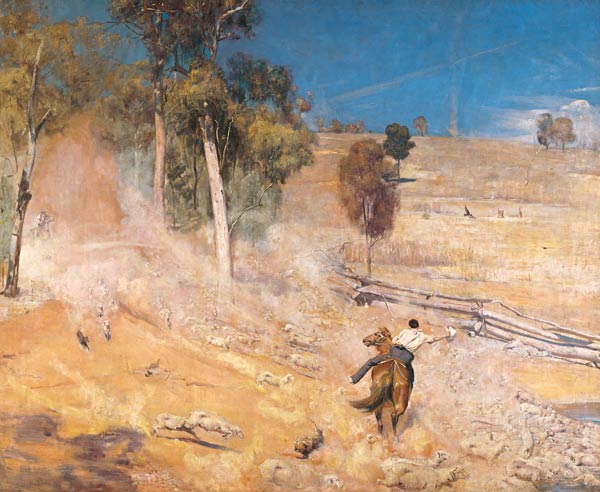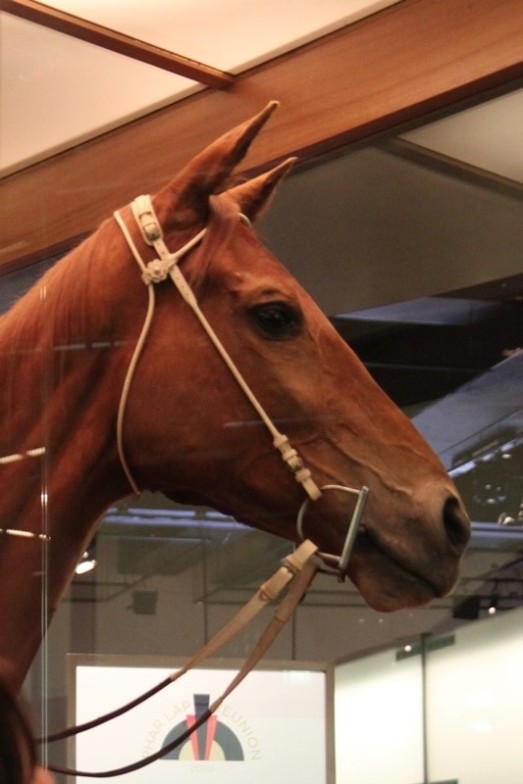The underdog narrative is popular in stories of Australian identity. Typically, an underdog is someone who, despite starting from behind, shows tenacity and fortitude to succeed against the odds. This spirit is frequently applied to descriptions of the Australian character, and the Phar Lap narrative is no exception. Ironically, while the story is rife with underdog characteristics in the way it is popularly constructed, if you look beyond the death of Phar Lap you will see what is far less frequently discussed, and that is that there were no happy endings, for any of the protagonists.
Phar Lap’s underdog status has been granted because of several factors. According to the story, he was initially dismissed by his owner David J. Davis on the basis of his looks. Second, once he started winning consistently, the racing establishment, which has been positioned as one of the main antagonists of the horse and his connections, tried to curb his streak by changing the weight-for-age scale of penalty weights.[1] However, whether this was a deliberate strategy designed to target and exclude a single horse, or was instead an attempt to open the field for other competitors, is a matter of perspective. Certainly the “anti-Establishment” angle is the favoured one. The idea that the Chairman of the Victoria Race Club (VRC) targeted Phar Lap, due to personal jealousy, is particularly emphasized in the 1983 film version of the story. However, as a registered Thoroughbred, Phar Lap was no less a pedigreed racehorse than any other competing on the field at that time.
Further to this, another popular aspect of the Phar Lap narrative, frequently cited to support the horse’s positioning as an underdog, was his “cheap” price at auction. However it should be remembered that the 160 guineas paid for him was still too great a sum for Harry Telford, the struggling trainer whose interest in the colt was piqued by the horse’s bloodlines, to afford. Instead, Telford persuaded wealthy businessman Davis to purchase the horse.
After his initial dismissal of the animal, Davis agreed to lease him to Telford for a period of three years. Though the horse did not perform well in his early starts as a two-year-old sprinter, and lost eight of his first nine races, starting him over longer distances as a three-year-old soon brought victory. By the time Telford’s lease of Phar Lap elapsed, he was a rich man. Harry Telford is frequently portrayed as the archetypal Aussie “battler” made good, and, while the usual narrative arc holds true when the focus remains on Phar Lap’s lifetime, when the gaze shifts beyond it, we see that Harry Telford’s success did not last long beyond Phar Lap’s death.
In fact this holds true for all the key human figures in the Phar Lap narrative. The Australian triumvirate of trainer (Telford), jockey (Jim Pike) and handler (Tommy Woodcock) can all be neatly positioned into pre-existing archetypes common to such stories – providing the narrative does not travel any further than Phar Lap’s death. Going beyond this artificial endpoint in the Phar Lap chronicle reveals a less-than-happy ending for all the protagonists.
Telford failed to train any significant winners after Phar Lap died in 1932. He soon had to surrender Braeside, the training facility he was able to establish with Phar Lap’s success, and eventually retired from racing in 1957. He died in 1960. Jimmy Pike, always fond of a drink and a bet, had never been physiologically suitable to be a jockey, being naturally of a larger frame. Nonetheless, in order to meet the requisite weights he frequently endured the regime of wasting common for jockeys in those days, which left him with ongoing stomach problems. He retired as a jockey several years after Phar Lap’s death, in 1936. He met no luck as a trainer, and eventually died in poverty in 1969.
Of the three men commonly associated with Phar Lap, Tommy Woodcock did not fall as far, perhaps because, as a strapper, he never attained the elevated profile of either Phar Lap’s trainer or jockey. After Phar Lap’s death, Woodcock achieved some success as a trainer, however, in 1977, when his horse Reckless was the sentimental favourite to win the Melbourne Cup, he was beaten by the “big money” – the Bart Cumming’s trained Gold and Black. Reality failed to deliver a narratively-satisfying happy ending to Woodcock’s story, either.
Finally, let us not forget the horse himself. Phar Lap, in spite of his success and popularity, died in excruciating agony from arsenic poisoning. Though the ongoing display of his preserved remains seem to deny the fact that he only lived for five years, this is merely a comforting fantasy. The stories of those associated with Phar Lap, including the horse himself, are manipulated so as to fit the narrative arc common to the underdog tale. It is this removal of Phar Lap from the normal birth-life-death cycle, and his insertion into life everlasting via the museum, which subsequently renders him a symbol, rather than just a horse who ran fast.
Interestingly, interpreting the figure of David Davis – both within and beyond the Phar Lap narrative arc – is more problematic. Perhaps as an American, Davis resists being stereotyped into an Australian narrative – or perhaps his foreign status renders him invisible. His story does not end in the same way as the others, as he continued to enjoy success as a racehorse owner, including owning another Melbourne Cup winner, Russia, who won in 1946. Though frequently portrayed as an antagonist to Telford and ascribed the blame for taking the horse to America where he died, Davis also not only paid a significant sum of money to have the skin mounted, but then donated the mount back to the people of Australia. As such, his role in the Phar Lap story resists any easy simplification.
Phar Lap is widely seen as embodying uniquely Australian characteristics. These, of course, can only be projections. The horse himself remains elusive. All that we have left of him are physical remains encased in glass within museum walls, along with some grainy footage. Photographs and racing memorabilia, such as race programs in which he is featured, frequently appear in the catalogues of auction houses. To own a part of Phar Lap is thought to be akin to owning a part of history. He has been positioned (both literally and metaphorically) as a key symbol of Australian identity.
Scholars of religion Carole Cusack and Justine Digance point out that Phar Lap sits alongside two other venerated Australian icons – the Anzacs at Gallipolli, and Ned Kelly – and argue that “all these heroes were ultimately ‘losers’: heroic achievers who died before their time”,[2] and further observe that “Australian icons persist in being somewhat iconoclastic.”[3] Nonetheless, Phar Lap’s “loser” status is not what is emphasised in the narratives that relate to him; instead, he is idolised for the way contemporary Australians view him.
Though initially renowned as a horse who brought hope to a generation during the Great Depression, the social and economic circumstances of that era now recede into the distant past, and the horse is memorialised today for different reasons. Phar Lap is seen as embodying key traits of Australianness. These are courage and tenacity, and achieving success despite the odds. However, as an historical figure, Phar Lap’s story needs to be shoe-horned slightly to fit the proscribed narrative arc of the underdog story. In reality, Phar Lap did succeed as a racehorse, by continuing to win races under increasingly heavy weight penalties. He was a popular figure of the day, though, as argued elsewhere, this is largely attributable to the emerging advances in media technology, which ensured his visibility.
Yet the horse continues to hold the nation’s imagination as a beloved symbol of Australian national identity. This symbolic status is evident in the deviation between what Phar Lap actually did, to an emphasis on what Phar Lap means to people.[4]
REFERENCES:
[1] Museum Victoria, Phar Lap webpage, accessed June 14, 2016 https://museumvictoria.com.au/pharlap/horse/winner.asp ; Biff Lowry, Killing Phar Lap: an Untold Part of the Story (Bloomington: AuthorHouse, 2014), 35.
[2] Carole M. Cusack and Justine Digance, “The Melbourne Cup: Australian Identity and Secular Pilgrimage,” Sport in Society: Cultures, Commerce, Media, Politics 12 (2009): 886, accessed August 1, 2014, doi: 10.1080/17430430903053109.
[3] Cusack and Digance, “The Melbourne Cup,” 886.
[4] Isa Menzies, “Phar Lap: From Racecourse to Reliquary,” ReCollections: a Journal of Museums and Collections 8 (2013).






